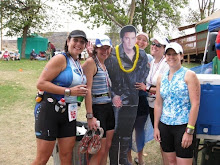Whether you're returning to the sport after taking time off or you're just starting out, the mental and physiological barriers that stand between you and your inner runner may seem insurmountable. Daniel Lieberman, Ph.D., a human evolutionary biologist at Harvard University and marathoner, says most people seem to have a threshold to cross when they start—or restart—the sport. "It takes time for blood vessels to respond, for your heart to get bigger and stronger, to add mitochondria to your muscles," he says. "But the good news is that our bodies are incredibly adaptive."
Returning runners know there's a payoff to sticking with it. Eight months after his 14-block slog, Hamilton ran a 1:36 half-marathon. Still, it's easy to get discouraged, especially when other runners glide past you, breathing as if they have some secret supply of oxygen. Here's how to overcome common early frustrations.
The Second Week Feels Harder Than the First
Feeling a little stiffness a week into an exercise routine is normal. "Soreness can be a sign that your muscles are adapting," says John Henwood, a 2004 New Zealand Olympian (10,000 meters) who's a coach in New York City. But if you're so achy you're shuffling, it's likely you were a little too enthusiastic out of the starting blocks. "When you begin a running program, your muscles are fresh, and you may have a rush of adrenaline, so you might be a little too ambitious," Henwood says. "The next week, you can feel the consequences."
Art Liberman, co-author of The Everything Running Book and founder of marathontraining.com, says experienced runners can fall into this trap if they expect to pick up their mileage or their speed where they left off. "It can be easy to do too much before you're ready for it," he says. "You don't realize it because initially you might feel great." Liberman suggests starting with—and sticking to—a conservative goal, such as run/walking for 20 minutes. Ending a run feeling like you're capable of doing more boosts confidence and is better than feeling beat up and discouraged. As you build mileage, don't increase distance by more than 10 percent per week.
Three Miles is Still Hard
Maybe it's because three miles is the classic "easy run," or that it's practically a 5K, but being able to cover this distance comfortably is often viewed as a sign that you've "arrived" as a runner. Just remember: Getting to this point can take anywhere from one to five months, depending on your fitness level and previous running experience. Veterans returning to the sport won't take as long to reach this comfort zone, says Tony Ruiz, distance coach of the Central Park Track Club in New York City and a 2:34 marathoner. Brand-new or overweight runners usually need more time to adapt. "When you are learning a new activity, your brain needs to build neural pathways that will give the muscles a sense of memory," Ruiz says. "Eventually, you aren't thinking about each step you take. The movement becomes natural, which is when it can become relaxed."That said, if you only know one pace—all out—three miles won't ever feel easy. Turning every run into a speed session will make every workout a challenge—and set you up for injury.
Even a Short Run Leaves Me Incredibly Sore
"Running demands movement from pretty much every part of your body," Ruiz says. "If many of those parts haven't been used in a while, if ever, you're bound to feel a little wrecked." To help ease these early discomforts, Ruiz recommends seeking out soft surfaces, such as dirt trails, as much as possible. Also, stick to flat routes since hills are extra taxing. Alternate running days with cross-training workouts, such as swimming, spinning, or yoga. Research shows that light exercise the day after a hard workout can alleviate soreness.Lieberman also encourages runners to focus on their footstrike and try to land with softer, lighter steps. "A lot of people thump and crash," he says. "That high collisional force can cause damage."
Finally, take care of yourself: Stretch postrun, ice sore spots, get plenty of sleep.





















1 comment:
This is pretty timely for me, just coming off a 3-month layoff! Patience is key.
Post a Comment